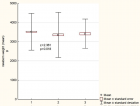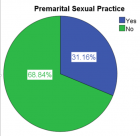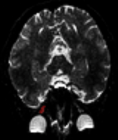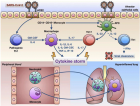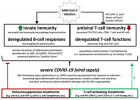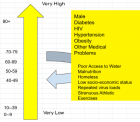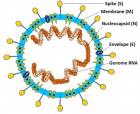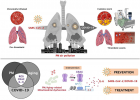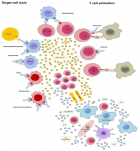Figure 7
COVID-19 immunologic and toxicological implication: Innate immune sensor and immune escape
Luisetto M*, Farhan Ahmad Khan, Khaled Edbey, Gamal Abdul Hamid, Mashori GR, Nili BA, Fiazza C, YesvI R and Latishev Yu O
Published: 25 March, 2021 | Volume 5 - Issue 1 | Pages: 001-017
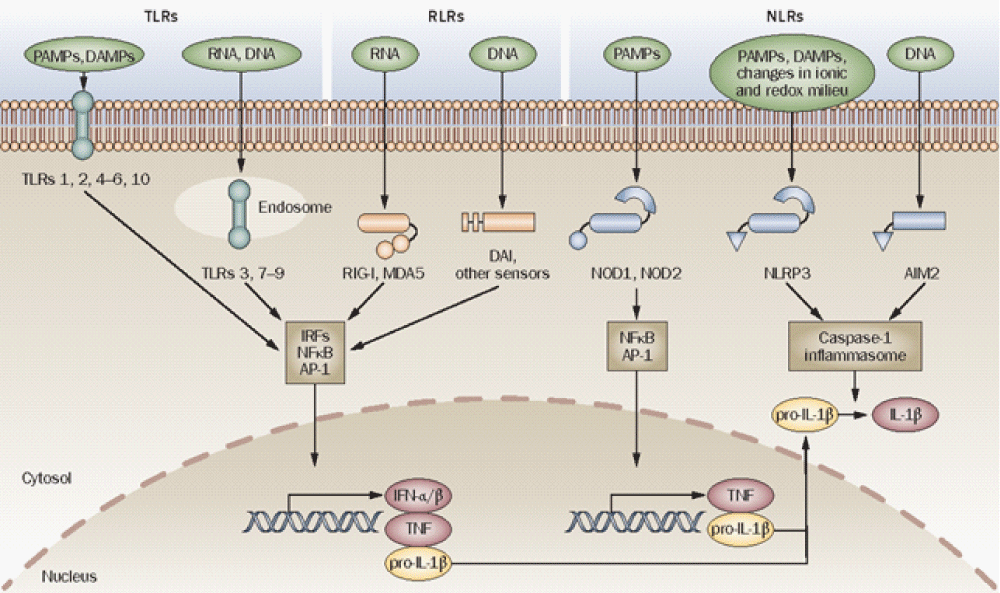
Figure 7:
Innate immune sensors. TLRs, RLRs ( RIG-I, MDA5, DAI and other sensors) and NLRs (for example, NOD1, NOD2, NLRP3 and AIM2) are innate -immune sensors that recognize danger signals derived from pathogens (PAMPs), damaged cells (DAMPs) or associated nucleic acids at the cell surface, in endo-lysosomes or in the cytoplasm. Signaling by these sensors promotes either the activation and nuclear translocation of transcription- factors (IRFs, NFB and AP-1) that drive expression of cytokines (IFN-/, TNF and pro-IL-1), or the assembly of the caspase-1 inflammasome and subsequent maturation of IL-1 from pro-IL-1. Abbreviations: AIM2, absent in melanoma 2; AP-1, activator protein 1; DAMP, danger associated molecular pattern; IFN, interferon; IL-1, interleukin-1; IRFs, interferon regulatory factors; MDA5, melanoma differentiation-associated gene-5; NFB, nuclear factor B; NLR, NOD-like receptor; NLRP, NLR with a pyrin domain; NOD, nucleotide-binding and oligomerization domain; PAMP, pathogen-associated molecular pattern; RIG-I, retinoid acid-inducible gene-I; RLR, RIG-I-like receptor; TLR, Toll-like receptor; TNF, tumor necrosis- factor [15].
Read Full Article HTML DOI: 10.29328/journal.apps.1001025 Cite this Article Read Full Article PDF
More Images
Similar Articles
-
COVID-19 immunologic and toxicological implication: Innate immune sensor and immune escapeLuisetto M*,Farhan Ahmad Khan,Khaled Edbey,Gamal Abdul Hamid,Mashori GR,Nili BA,Fiazza C,YesvI R,Latishev Yu O. COVID-19 immunologic and toxicological implication: Innate immune sensor and immune escape. . 2021 doi: 10.29328/journal.apps.1001025; 5: 001-017
-
Pefloxacin and its derivative, novel inhibitors of the SARS-CoV-2 Main protease (3CLpro) and their pharmacokinetics prediction: An in silico analysisEmmanuel Oluwaseun Adediran*. Pefloxacin and its derivative, novel inhibitors of the SARS-CoV-2 Main protease (3CLpro) and their pharmacokinetics prediction: An in silico analysis. . 2022 doi: 10.29328/journal.apps.1001030; 6: 013-018
-
Status of hemodialysis patients using complementary and alternative medicine practices during the COVID-19 pandemicSevil Güler*,Seda Şahan. Status of hemodialysis patients using complementary and alternative medicine practices during the COVID-19 pandemic. . 2022 doi: 10.29328/journal.apps.1001033; 6: 024-029
Recently Viewed
-
Minds after Death: The Expanding Role of Psychological Autopsy in Investigations: A ReviewIshan Jain*,Oindrila Mahapatra,Yogesh Kumar. Minds after Death: The Expanding Role of Psychological Autopsy in Investigations: A Review. J Forensic Sci Res. 2025: doi: 10.29328/journal.jfsr.1001096; 9: 155-0
-
Role of Perianesthesia Nurses in Enhanced Recovery After Surgery (ERAS) Protocols: A Narrative Review and Comparative Outcomes AnalysisOghogho Linda Akarogbe*,Geneva Igwama,Olachi Lovina Emenyonu,Idowu M Ariyibi. Role of Perianesthesia Nurses in Enhanced Recovery After Surgery (ERAS) Protocols: A Narrative Review and Comparative Outcomes Analysis. Int J Clin Anesth Res. 2025: doi: 10.29328/journal.ijcar.1001034; 9: 037-039
-
Brain washing systems and other circulating factors in some neurological condition like Parkinson (Pd) and vascular and diabetic dementia: How dynamics- saturation of clearance can act on toxic molecule?Mauro Luisetto*,Farhan Ahmad Khan,Akram Muhamad,Ghulam Rasool Mashori,Behzad Nili Ahmadabadi,Oleg Yurevich Latiyshev. Brain washing systems and other circulating factors in some neurological condition like Parkinson (Pd) and vascular and diabetic dementia: How dynamics- saturation of clearance can act on toxic molecule?. J Neurosci Neurol Disord. 2020: doi: 10.29328/journal.jnnd.1001028; 4: 001-013
-
Do genes matter in sleep?-A comprehensive updateRajib Dutta*. Do genes matter in sleep?-A comprehensive update. J Neurosci Neurol Disord. 2020: doi: 10.29328/journal.jnnd.1001029; 4: 014-023
-
Obesity may increase the prevalence of Parkinson’s Disease (PD) while PD may reduce obesity index in patientsLi Xue Zhong*,Muslimat Kehinde Adebisi,Liuyi,Mzee Said Abdulraman Salim,Abdul Nazif Mahmud,Aaron Gia Kanton,Abdullateef Taiye Mustapha. Obesity may increase the prevalence of Parkinson’s Disease (PD) while PD may reduce obesity index in patients. J Neurosci Neurol Disord. 2020: doi: 10.29328/journal.jnnd.1001030; 4: 024-028
Most Viewed
-
Feasibility study of magnetic sensing for detecting single-neuron action potentialsDenis Tonini,Kai Wu,Renata Saha,Jian-Ping Wang*. Feasibility study of magnetic sensing for detecting single-neuron action potentials. Ann Biomed Sci Eng. 2022 doi: 10.29328/journal.abse.1001018; 6: 019-029
-
Evaluation of In vitro and Ex vivo Models for Studying the Effectiveness of Vaginal Drug Systems in Controlling Microbe Infections: A Systematic ReviewMohammad Hossein Karami*, Majid Abdouss*, Mandana Karami. Evaluation of In vitro and Ex vivo Models for Studying the Effectiveness of Vaginal Drug Systems in Controlling Microbe Infections: A Systematic Review. Clin J Obstet Gynecol. 2023 doi: 10.29328/journal.cjog.1001151; 6: 201-215
-
Prospective Coronavirus Liver Effects: Available KnowledgeAvishek Mandal*. Prospective Coronavirus Liver Effects: Available Knowledge. Ann Clin Gastroenterol Hepatol. 2023 doi: 10.29328/journal.acgh.1001039; 7: 001-010
-
Causal Link between Human Blood Metabolites and Asthma: An Investigation Using Mendelian RandomizationYong-Qing Zhu, Xiao-Yan Meng, Jing-Hua Yang*. Causal Link between Human Blood Metabolites and Asthma: An Investigation Using Mendelian Randomization. Arch Asthma Allergy Immunol. 2023 doi: 10.29328/journal.aaai.1001032; 7: 012-022
-
An algorithm to safely manage oral food challenge in an office-based setting for children with multiple food allergiesNathalie Cottel,Aïcha Dieme,Véronique Orcel,Yannick Chantran,Mélisande Bourgoin-Heck,Jocelyne Just. An algorithm to safely manage oral food challenge in an office-based setting for children with multiple food allergies. Arch Asthma Allergy Immunol. 2021 doi: 10.29328/journal.aaai.1001027; 5: 030-037

HSPI: We're glad you're here. Please click "create a new Query" if you are a new visitor to our website and need further information from us.
If you are already a member of our network and need to keep track of any developments regarding a question you have already submitted, click "take me to my Query."






